Whether we’re discussing an interesting clinical case or talking about some juicy gossip with our friends, our use of language is without a doubt an important aspect and part of daily life and how we function in society.
The fascinating thing about language is that there have been some common themes and motifs that are spread throughout most languages throughout the world, even languages that are extinct like Latin and Coptic!
This chapter overview will introduce you all to some important aspects of language development including common components and theories. Let’s dive in!
Language Development on the MCAT: What You Need to Know
Topics on sensation and perception will be tested on the Psych/Soc section of the MCAT and can appear both as passage based and fundamental discrete questions.
Don’t worry if you can’t put much emphasis into reviewing this section, as we’ve calculated that only about 2-3 questions are probably gonna test topics on language development.
Introductory psychology accounts for 65% of the content covered in the Psychological, Social, and Biological Foundations of Behavior, while introductory sociology covers about 30 of the content.
Important Sub-Topics: Language Development
The most interesting idea to take away from this section is that there’s an interconnected influence between language and cognition: language can affect our cognition while in the same cognition can influence our language and how we communicate with the world!
Furthermore, you’ll see different arguments and theories about how language is learned and developed. You’ll notice that these different arguments are similar to the arguments concerning how we even learn tasks and behaviors in general!
1. Common Elements of Language
As mentioned above, there are a lot of common features that are present in various languages throughout the world! In spoken languages, there are generally 3 points of interest when it comes to studying that particular language: sound, structure, and meaning.
With sound, we’re obviously interested in how the vocabulary of the language sounds in pronunciation. The structure requires us to see how words and sentences are formed. Finally, meaning allows us to see what the phrase is trying to express.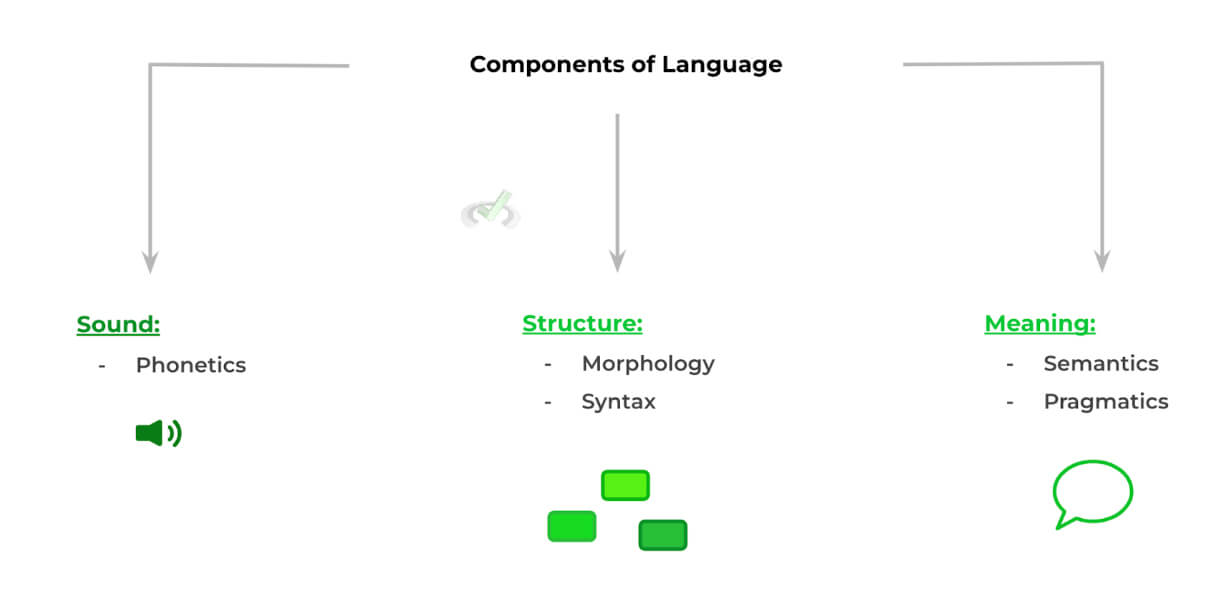
The phonetics of a language directly focuses on how words are pronounced! You’ve probably seen this in dictionaries, where beside the bolded vocabulary word is the phonetic pronunciation of the word as shown below:

Moving onto the structure, morphology refers to how words themselves are actually constructed and common patterns observed to give words meaning. A common way to think of this is the use of prefixes and suffixes.
Furthermore, syntax goes a step further and is concerned with the rules in regard to how to order and arrange words in sentences and phrases and how these guidelines direct the meaning.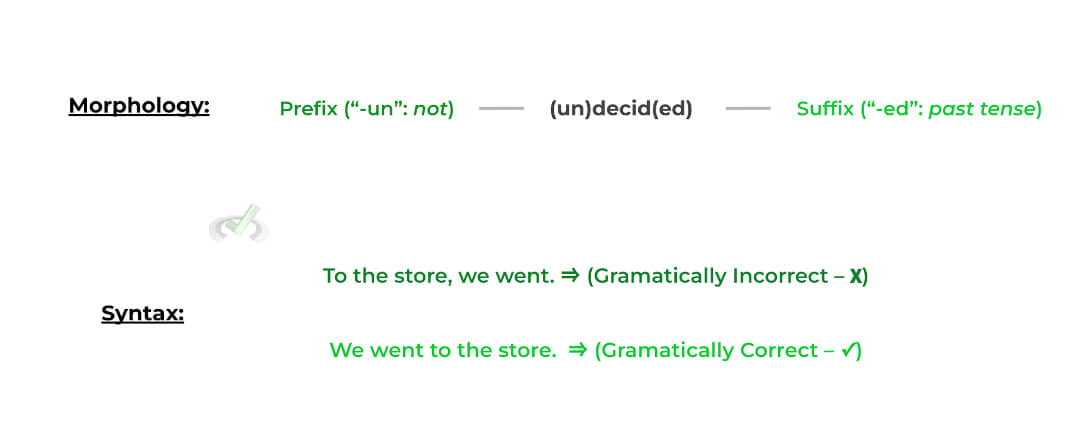
Finally, in regards to attaching meaning, semantics is interesting in the actual meaning of the word: this doesn’t necessarily only refer to the definition but also to the more abstract concepts such as similes, analogies, etc.
Pragmatics refers to how the meaning of a word, sentence, or phrase can be altered depending on various external factors and contexts. These can include differences in tone, the background context of the conversation, etc.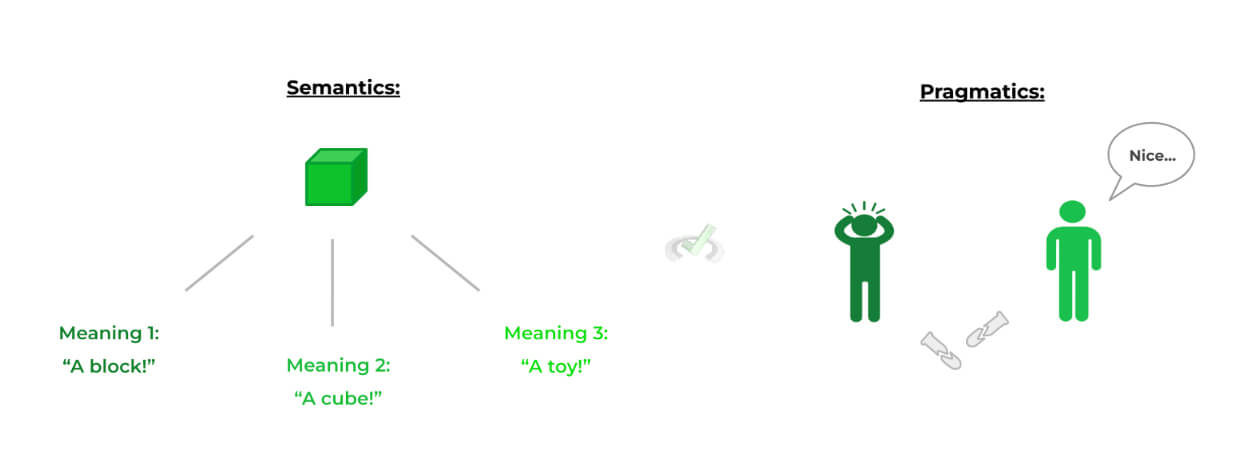
Full Study Notes : Common Elements of Language on the MCAT
For more in-depth content review on the main components of language, check out these detailed lesson notes created by top MCAT scorers.
2. Theories of Language Development
Over the course of linguistic studies, there have been many different theories to explain how language develops throughout our lifetime. It’s amazing how we’ve been able to go from a babbling baby to being able to fully comprehend our native language!
One theory that gives support to nature is nature v.s. nurture debate is the nativist theory: this states that everyone has an innate ability to learn a language and has the intrinsic brain tools to learn the language.
Nativist theorists support the presence of a language acquisition device (LAD), which is one of the “hypothetical brain learning tools'' that's present in all humans and aids in the learning of a language. This, combined with a critical period of language acquisition, explains the natural learning process for learning a language.
There are many cases that support the idea of a language acquisition device in humans and allow for their innate ability to learn languages. For example, though apes are able to learn simple words, they’ve never been able to grasp concepts of syntax, supporting that most likely only humans have the LAD.
On the opposite spectrum is the behaviorist theory which supports the importance of reinforcement and constant exposure to language is required! Specifically, this theory relies heavily on the use of operant conditioning when learning a language.
Recall that operant conditioning is a type of conditioning technique that relies on reinforcement and punishment conditions in order to promote certain behavior. These can further be categorized into positive and negative conditions, whether something is “added” or “subtract.”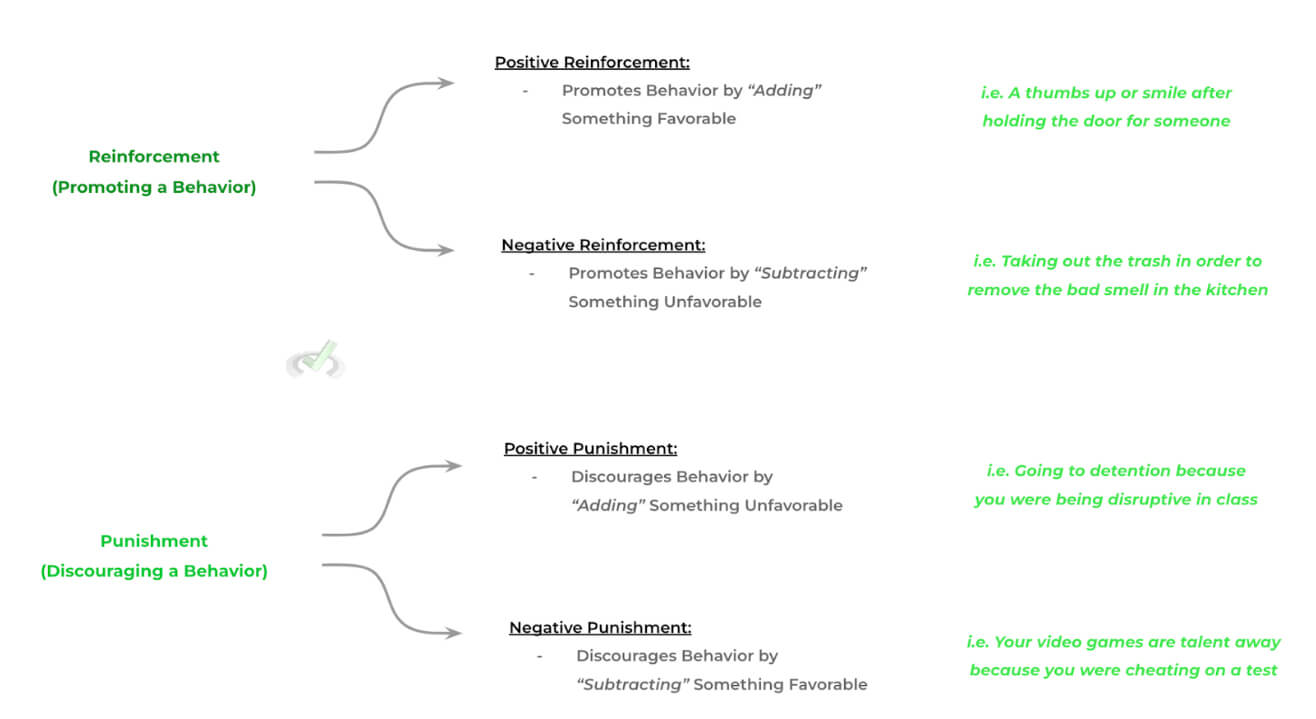
This theory is heavily reliant on the caretakers of children as they are the ones that provide the “reinforcement” or “punishment” strategies in order for the children to learn the correct rules of a language!
For example, when a 4 year old sees a dog and says, “It’s a dog!” the caretaker can reward the correct use of language by saying, “You’re right, good job!” In this case, this can be viewed as a positive reinforcement as a behavior (i.e., correct use of language) is promoted by the addition of something favorable (i.e., words of encouragement.)
On the other hand, if the 4 year old sees a dog and says, “It’s a cat,” the caretaker will correct for the incorrect use of language by saying, “No honey, that’s a dog” — here, you can view this as positive punishment as the behavior (i.e., incorrect use of language) is discouraged by the addition of something unfavorable (i.e., correction).
Finally, a great “in between” and compromise between the nativist and behavior theory is the social-interactionist theory of language development. The driving force behind this theory is the importance of socialization with others to learn a language!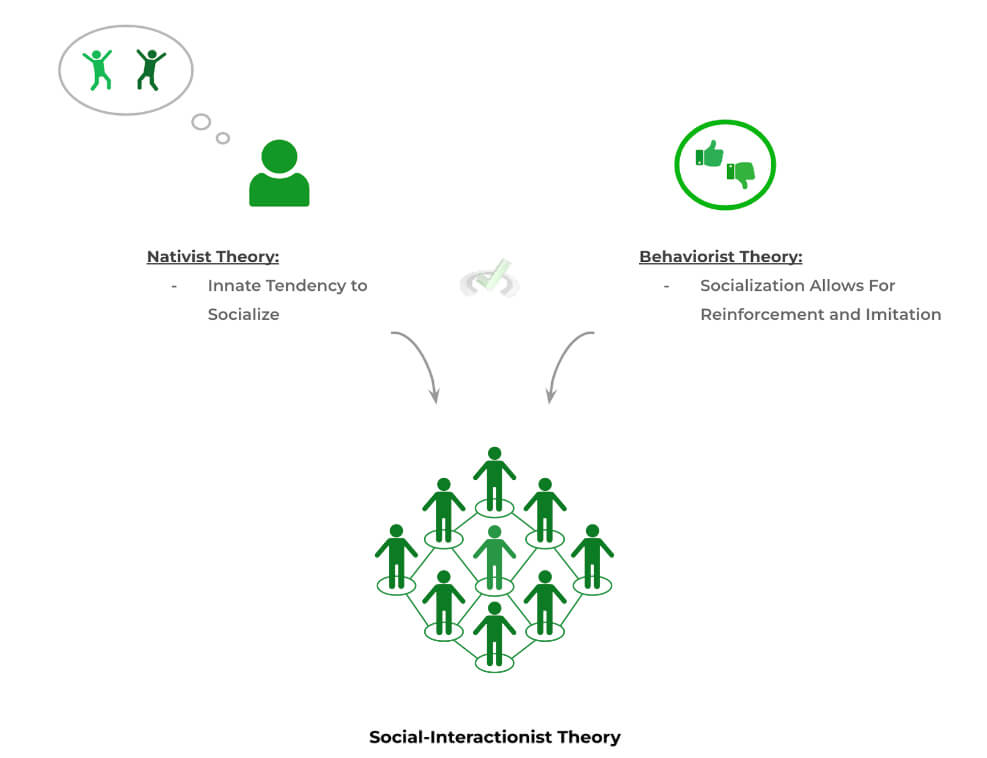
Like the behaviorist theory, social interaction is emphasized in order to allow for critique and correction when a child speaks. Additionally, like nativist theory, social interactionists also support an individual's inherent ability to learn language — in this case, it supports an innate tendency and desire to socialize with others!
Full Study Notes : Theories of Language Development on the MCAT
For more in-depth content review on the different theories of language development, check out these detailed lesson notes created by top MCAT scorers.
3. Effect of Language on Brain Biology and Cognition
Let’s now take a step further and see how language can affect our brain’s biology as well as how it can affect the way we think! We’ll take a look at 2 different hypotheses at opposite extremes: language influences cognition and cognition influences language.
On the one extreme, we see that the Sapir-Whorfian hypothesis — also called linguistic determinism — supports the notion that language influences the way the think and perceive the world.
To give an example, try to imagine the direction a person begins to run from a starting position. If you primarily communicate in English, Spanish, or any of the romantic languages, you probably imagined the person running left to right.
However, as shown above, if your primary language is one of the Semitic languages such as Arabic or Hebrew, you may have pictured the person running from right to left just like the language. This is just one example of how language might influence cognition in the case of the Sapir-Whorfian hypothesis.
On the other end of the spectrum is universalism, which supports the opposing notion that cognition influences languages. It’s rather hard to give a concrete example, but another phrase to picture this idea is “If you can think it, you can say it!”.
Finally, let’s look at some of the main brain regions involved in language and their main functions in helping us communicate via languages! 2 important brain regions involved in language are Broca’s area and Wernicke’s area: these are the brain regions responsible for language production and language comprehension, respectively.
Another important brain region involved in language is the arcuate fasciculus, which is a collection of axons that allows for the intercellular connections between Broca’s and Wernicke’s areas.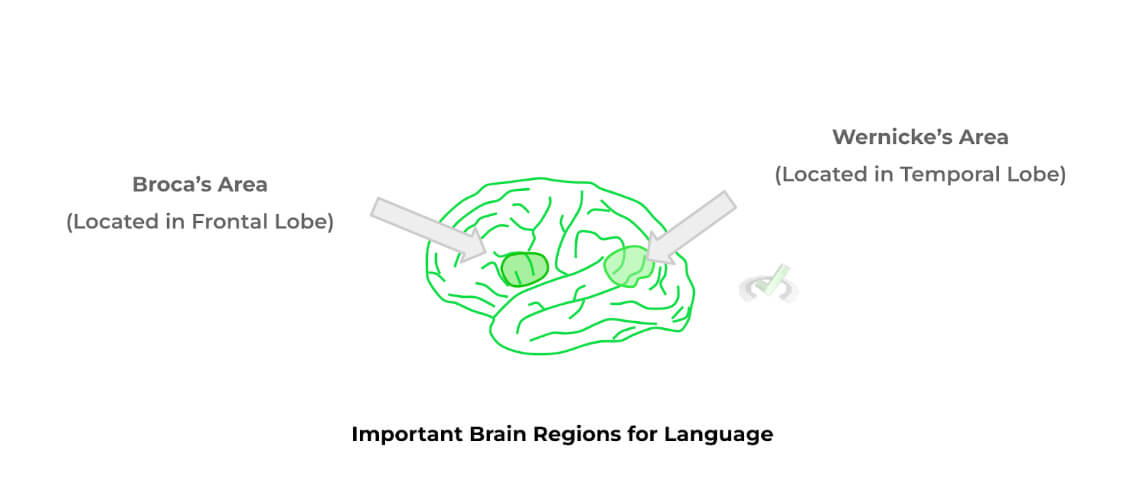
In order to give tie back to some neurobiology topics, let’s take a look at the specific lobes that each area is located in! Broca’s area is located in the frontal lobe while Wernicke’s area is located in the temporal lobe.
This should make sense because the frontal lobe is important for functions such as motor control — which would allow for speech production — while the temporal lobe has been associated with language comprehension and understanding!
Full Study Notes : Effect of Language on Brain Biology and Cognition on the MCAT
For more in-depth content review on how language can affect us at a cognitive level as well as the main neurobiological components, check out these detailed lesson notes created by top MCAT scorers.
Important Definitions and Key Terms
Below are some high yield definitions and key terms to refer to when reviewing concepts and ideas about language development!
Term | Definition |
|---|---|
Phonetics | The portion of linguistics which is interested in the pronunciation and “sounding out” of vocabulary within a language |
Morphology | The study in linguistics which specializes in how words are built in order to give themselves meaning |
Syntax | The subfield of linguistics which refers to the rules in regards to how words are arranged and ordered within sentences or phrases |
Semantics | The subspecialty of linguistics which is interested in the actual meaning of words and how words can have multiple meanings |
Pragmatics | The field of linguistics which studies how meanings of a word/phrase/sentence can change depending on the surrounding context |
Nativist Theory | A theory of language development which suggests that all humans have an innate ability to learn language |
Language Acquisition Device (LAD) | Refers to a theoretical tool within human’s brain that is responsible for our innate capacity to learn language |
Behaviorist Theory | A theory of language development that supports the need of reinforcement in order for language to be learned |
Operant Conditioning | A type of conditioning technique which relies on reinforcement and punishment conditions in order to promote (or suppress) a behavior |
Social-Interactionist Theory | A theory of language development which combines aspects of nativist and behaviorist theories, with an emphasis on the need for social interaction in order for language development to occur |
Sapir-Whorfian Hypothesis | Supports the idea that our language can affect our cognition (i.e. the way we think and perceive the world) |
Universalism | Supports the idea that our cognition affects our language; in other words, “if you can think it, you can say it!” |
Broca’s Area | An area within the frontal lobe of the cerebral cortex which is involved with language production |
Wernicke’s Area | An area within the temporal lobe of the cerebral cortex which is involved with language comprehension |
Arcuate Fasciculus | A series of axonal connections between Broca’s and Wernicke’s area which allows for their intercellular communication |
Additional FAQs - Language Development on the MCAT
A. What are the 4 Theories of Language Development?
B. What are the 6 Main Stages of Language Development – MCAT?
C. What is the Nativist Hypothesis – MCAT?
Additional Reading Links – Study Notes for Language Development on the MCAT
Additional Reading:
- Identity and Personality on the MCAT
- Cognition and Consciousness on the MCAT
- Learning and Memory on the MCAT
- Motivation and Emotion on the MCAT
- Neurobiology on the MCAT
- Psychological Disorders on the MCAT
- Sensation and Perception on the MCAT
- Social Interaction on the MCAT
- Social Processes and Behavior on the MCAT
- Social Structure and Stratification on the MCAT
- Social Thinking and Attitudes on the MCAT







 To help you achieve your goal MCAT score, we take turns hosting these
To help you achieve your goal MCAT score, we take turns hosting these 





















 reviews on TrustPilot
reviews on TrustPilot